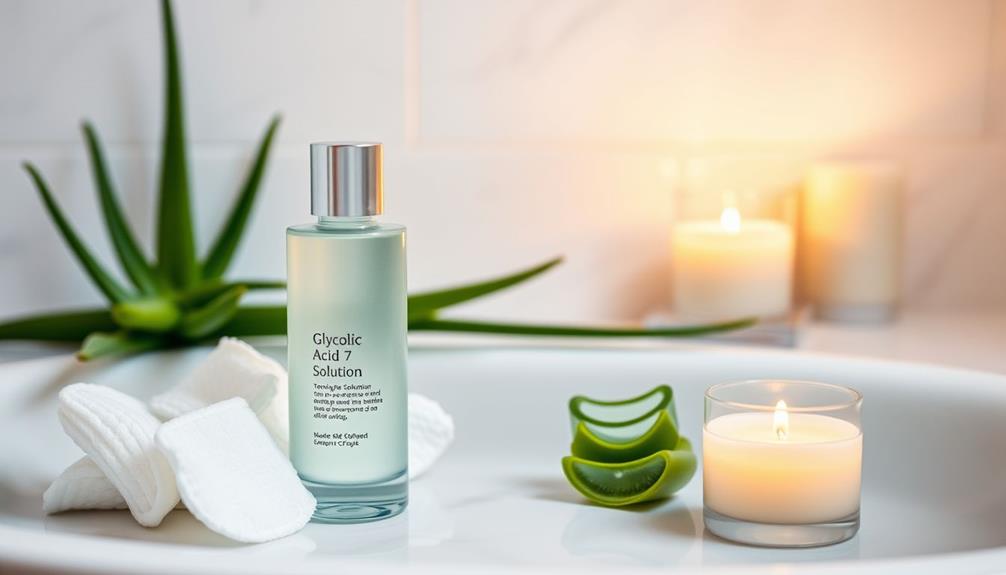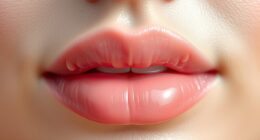Glycolic acid is your go-to for smoother, brighter skin. This powerful exfoliant helps speed up cell turnover, leaving your complexion refreshed and radiant. It targets dark spots and uneven tone while reducing fine lines by stimulating collagen production. Suitable for normal-to-combination skin, you can start using it once or twice a week, gradually increasing as your skin adjusts. Just remember to follow up with sunscreen, as glycolic acid can make your skin more sensitive to the sun. Want to reveal more tips on how to incorporate it into your skincare routine? There's plenty more to explore!
Key Takeaways
- Glycolic acid, an alpha hydroxy acid, promotes cell turnover for smoother and brighter skin by exfoliating dead skin cells.
- It improves skin clarity, reduces breakouts, and addresses dark spots and hyperpigmentation for a more even skin tone.
- Regular use stimulates collagen production, helping to minimize fine lines and wrinkles, contributing to youthful-looking skin.
- Ideal for normal-to-combination skin, glycolic acid should be introduced gradually, especially for sensitive skin types.
What Is Glycolic Acid?

Glycolic acid is a powerful exfoliant derived from sugar cane that effectively rejuvenates your skin by promoting cell turnover.
As an alpha hydroxy acid (AHA), it's known for its remarkable exfoliating properties. Its small molecular weight allows glycolic acid to penetrate the skin more deeply than other acids, making it a highly effective chemical exfoliant.
Additionally, incorporating essential oils for skin health can enhance your skincare routine, providing added benefits for your complexion.
When you apply glycolic acid, it works by dissolving the bonds that hold dead skin cells together. This process not only removes those cells but also improves your overall skin texture, resulting in a smoother appearance.
By encouraging the shedding of dead skin, glycolic acid paves the way for fresh, new skin to emerge.
Additionally, this acid stimulates collagen production, an essential factor in maintaining youthful skin.
With regular use of skincare products containing glycolic acid, you can experience noticeable improvements in your skin's brightness and clarity.
Whether found in cleansers, serums, or peels, glycolic acid is versatile and can address a variety of skin concerns, making it a staple in any effective skincare routine.
Key Benefits for Skin

Experience smoother, brighter skin with the key benefits of glycolic acid, which include enhanced cell turnover and reduced signs of aging. This powerful exfoliating agent works by sloughing off dead skin cells, promoting a smoother texture that reveals your skin's natural radiance.
As glycolic acid encourages cell turnover, you'll notice improved skin clarity and a reduction in breakouts, as it cleanses pores and prevents the buildup of impurities. Additionally, incorporating relaxation techniques like deep breathing can complement your skincare routine by reducing stress, which is known to impact skin health natural ways to enhance skin health.
One of the standout benefits of glycolic acid is its ability to tackle dark spots and hyperpigmentation. By breaking down excess pigment, it helps achieve a more even skin tone.
Additionally, glycolic acid stimulates collagen production, which plays an essential role in minimizing fine lines and wrinkles, giving your skin a youthful appearance.
Clinical studies show that regular use of glycolic acid can even increase epidermal thickness by up to 27% in six months, demonstrating its effectiveness in skin rejuvenation.
With consistent application, you'll not only enjoy a brighter complexion but also a significant reduction in signs of aging, making glycolic acid a must-have in your skincare routine.
Ideal Skin Types

Many skin types can benefit from glycolic acid, particularly normal-to-combination skin, which thrives on its ability to enhance texture and tone.
This powerhouse ingredient excels at exfoliation, helping to remove dead skin cells and revealing a smoother, more radiant complexion. Additionally, using products that incorporate natural ingredients, like Ryze Organic Mushroom Coffee, can further support skin health from the inside out.
If you're dealing with hyperpigmentation or melasma, glycolic acid can be your ally, effectively diminishing dark spots and evening out your skin tone.
For those with sun damage, glycolic acid can also provide relief by promoting exfoliation and stimulating collagen production, leading to improved skin appearance.
However, if you have sensitive skin, you need to exercise caution. Glycolic acid may cause irritation, so it's essential to conduct patch testing before applying it to larger areas.
Starting with lower concentrations and gradually increasing usage can help you avoid adverse reactions.
How to Use Glycolic Acid
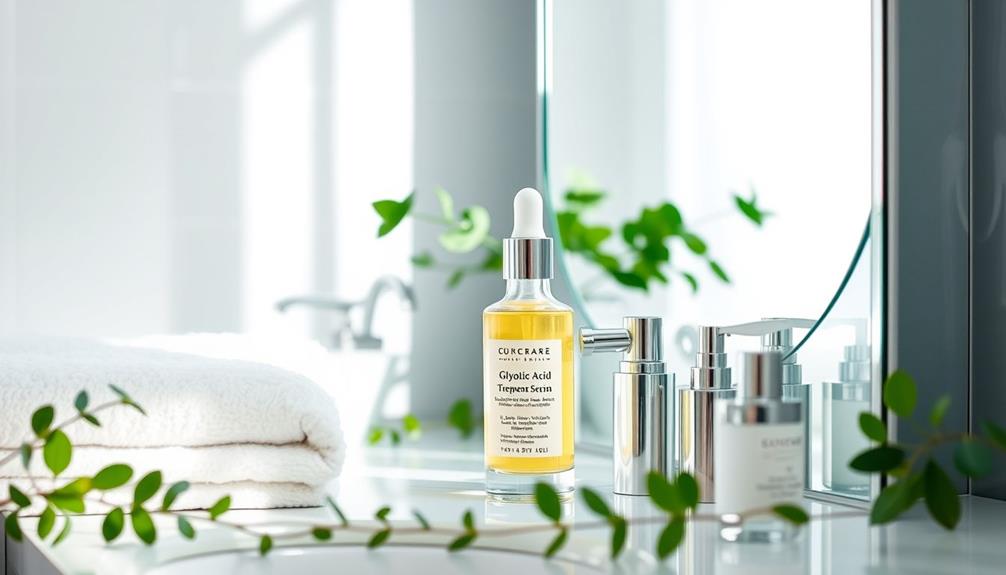
When you're ready to use glycolic acid, start slow—apply it once or twice a week and adjust based on your skin's reaction.
It's crucial to evaluate how glycolic acid can complement other treatments, such as aromatherapy techniques, which may enhance your overall skincare routine.
Layer it properly with your other products, making sure to apply it before your moisturizer.
Also, keep your skin type in mind to find the right balance and avoid irritation.
Application Frequency Guidelines
To safely incorporate glycolic acid into your skincare routine, start by using it once or twice a week to help your skin adjust and reduce the risk of irritation.
This gradual approach allows your skin to build tolerance to this powerful chemical exfoliator. If you have normal to combination skin, you might consider using products with lower concentrations (5-10%) more frequently, like in cleansers or toners, potentially even daily.
Before jumping in, patch testing is vital, especially if you have sensitive skin. Apply a small amount on a discreet area to gauge your skin's reaction. If you experience any redness or irritation, it's best to wait longer before increasing the frequency.
Once you're comfortable with glycolic acid, remember to pair it with broad-spectrum sunscreen during the day. Glycolic acid can increase your skin's sensitivity to UV rays, making sun protection essential.
Also, avoid using glycolic acid simultaneously with retinoids or benzoyl peroxide to prevent excessive irritation.
Layering With Other Products
Layering glycolic acid correctly with other products can greatly enhance your skincare routine's effectiveness and guarantee your skin stays healthy.
Start by applying glycolic acid after cleansing, making certain it penetrates well before you layer on any serums or moisturizers. This maximizes its exfoliating benefits, helping to reveal smoother, brighter skin.
However, be cautious when combining glycolic acid with other active ingredients. Avoid using it simultaneously with retinoids or benzoyl peroxide, as this can lead to irritation and increase skin sensitivity. For best results, incorporate glycolic acid into your nighttime routine to minimize sun exposure risks.
Before diving in, always perform a patch test, especially if you're new to glycolic acid. This step helps make sure your skin can tolerate the product without adverse reactions.
After applying glycolic acid, follow up with a nourishing moisturizer that contains soothing ingredients like ceramides. This will help maintain hydration and support your skin barrier after exfoliation.
Skin Type Considerations
Understanding your skin type is essential for using glycolic acid effectively and safely. This powerful ingredient can be a game-changer for many, but it's vital to tailor its use to your specific skin needs to avoid irritation.
Here are three key considerations based on your skin type:
- Normal-to-Combination Skin: If this describes you, glycolic acid can help address issues like hyperpigmentation and melasma. Start with a concentration of 5-10%, using it once or twice a week.
- Sensitive Skin: If you have sensitive or rosacea-prone skin, approach glycolic acid cautiously. Before full application, perform patch testing to check for any adverse reactions.
- Sunscreen: Regardless of your skin type, always use sunscreen while incorporating glycolic acid into your routine. It increases your skin's sensitivity to UV exposure, so a broad-spectrum SPF of at least 30 is vital.
Recommended Products
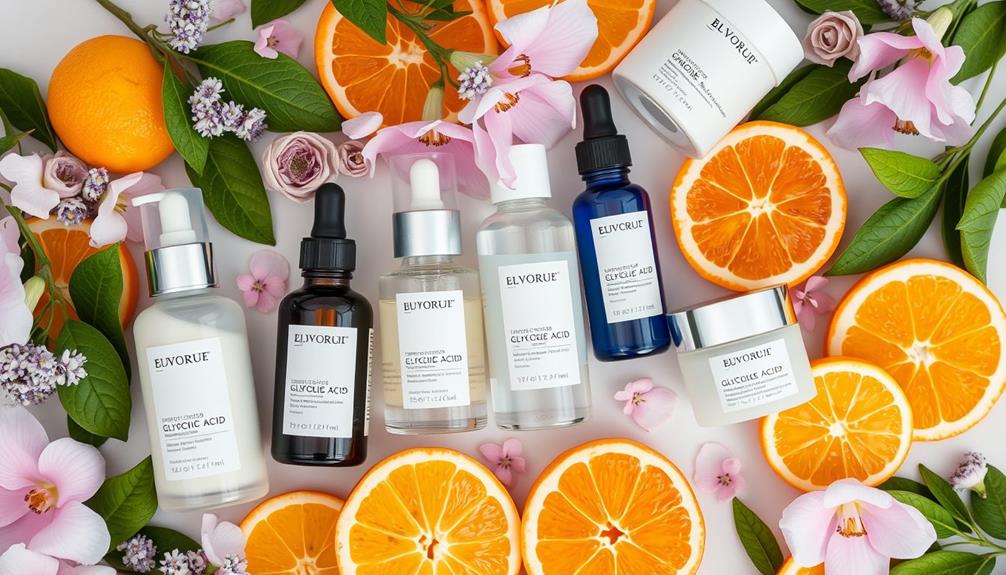
Discover a selection of high-quality glycolic acid products that can transform your skincare routine and help achieve smoother, more radiant skin.
Start with the Self Smooth 10% Glycolic Resurfacing Serum for brightening your complexion and improving skin tone. It's a perfect choice if you're after enhanced radiance.
For larger areas, consider the Smoother Glycolic Acid Body Lotion; it targets dry skin and rough patches, leaving your skin feeling silky and smooth.
Incorporate the Glycolic Acid 7% Exfoliating Toning Solution into your daily routine to clear pores and boost product absorption, making it a fantastic addition to your exfoliating acids arsenal.
If you want a thorough approach to skin rejuvenation, the Super Radiance Resurfacing Facial Treatment combines AHAs, BHAs, and PHAs for multiple benefits.
Application Methods

When it comes to applying glycolic acid, you've got several effective methods at your disposal.
Cleansers and toners can gently introduce the ingredient into your routine, while serums target specific concerns directly.
For a more intensive treatment, at-home peels offer deeper exfoliation to help you achieve smoother skin.
Cleansers and Toners
Glycolic acid cleansers and toners offer effective application methods that enhance skin exfoliation while minimizing irritation. These products work together to remove dead skin cells and impurities, leading to improved skin texture and a brighter complexion.
Here's how to incorporate them into your routine:
- Cleanse: Start with a glycolic acid cleanser like the GlyPro AHA Resurfacing Cleanser, which contains 10% glycolic acid and soothing ingredients like aloe vera. This helps gently exfoliate while calming your skin.
- Tone: After cleansing, use a glycolic acid toner. Saturate a cotton pad and sweep it across your face and neck to refine pores and boost exfoliation. This step is essential for enhancing the effects of your cleanser.
- Moisturize and Protect: Follow up with a moisturizer and apply SPF in the morning to protect your newly brightened skin.
Serums for Targeted Treatment
Serums containing glycolic acid provide a potent solution for targeting specific skin issues, helping you achieve clearer and smoother skin with regular use.
These serums typically feature higher concentrations of glycolic acid, ranging from 5% to 10%, which allows for effective exfoliation and deeper penetration.
Whether you're dealing with hyperpigmentation, fine lines, or uneven texture, glycolic acid serums can address these skin concerns effectively.
For ideal results, apply these serums on clean, dry skin, guaranteeing you use them before your moisturizer. This method enhances absorption and maximizes the benefits.
As you begin incorporating glycolic acid into your routine, it's essential to assess your skin tolerance. Start with a lower concentration and gradually increase usage frequency to avoid irritation, especially if you have sensitive skin.
Patch testing is also advisable to confirm your skin can handle the product.
With consistent use, many users report visible improvements in skin clarity and texture within weeks, experiencing smoother skin through regular application.
At-Home Peel Options
Regularly using at-home glycolic acid peels can greatly enhance your skincare routine by delivering professional-like results in just a few easy steps. These peels typically contain glycolic acid concentrations ranging from 10% to 30%, promoting skin cell turnover while being safe for home use.
Here's how you can get started:
- Perform a Patch Test: Before applying any glycolic acid peel, test a small area of skin to check for sensitivity and avoid adverse reactions.
- Follow Manufacturer Instructions: Apply the peel according to the guidelines, usually once every one to two weeks. This guarantees you reap the benefits without overwhelming your skin.
- Post-Peel Care: After the peel, it's crucial to apply a broad-spectrum sunscreen daily. Glycolic acid increases your skin's sensitivity to sun exposure, making it more vulnerable to damage.
Safety and Side Effects

When incorporating glycolic acid into your skincare routine, be aware of potential skin irritation, redness, or burning sensations, especially if you have sensitive skin. To minimize these risks, it's important to perform a patch test before fully applying the product. This will help you assess your skin's tolerance to glycolic acid.
Here's a quick overview of potential side effects and recommendations:
| Side Effect | Recommendation |
|---|---|
| Skin Irritation | Start with lower concentrations |
| Sun Sensitivity | Apply sunscreen daily |
| Patch Test | Test on a small area first |
| Gradual Introduction | Limit use to once or twice a week |
Increased sun sensitivity is a common side effect, making daily sunscreen application essential to protect your skin from UV damage. If you experience significant discomfort or persistent irritation after using glycolic acid, consult a dermatologist for guidance. By taking these precautions, you can enjoy the benefits of glycolic acid while minimizing adverse reactions and keeping your skin healthy.
Incorporating Into Your Routine
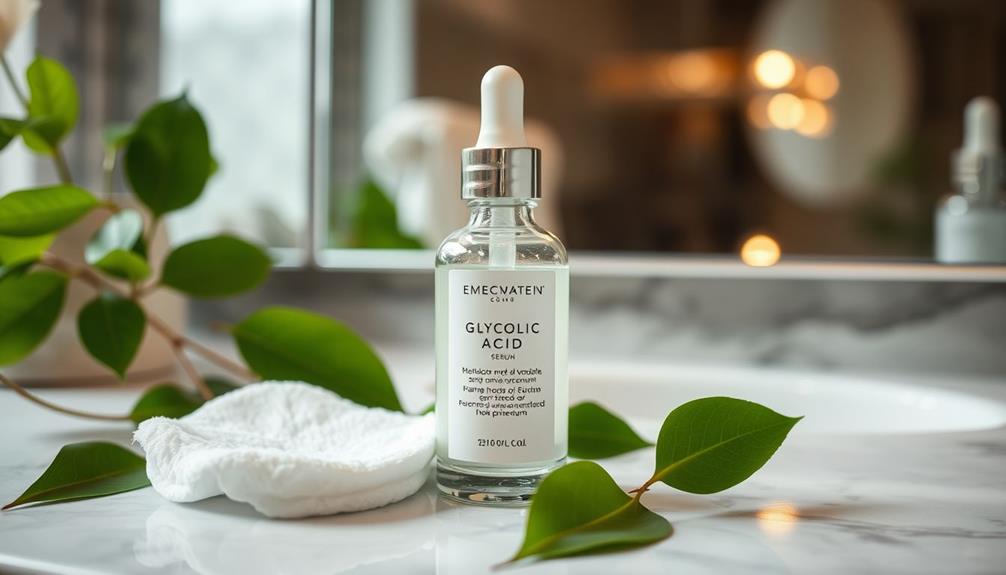
To effectively incorporate glycolic acid into your routine, start by using it once or twice a week to gauge how your skin responds. This gentle exfoliator works by removing dead skin cells and improving skin texture, making it essential for achieving smoother, brighter skin. If you have sensitive skin, consider beginning with a lower concentration (around 5-10%) to minimize irritation.
Here are three key steps to follow:
- Choose Your Product: Start with a glycolic acid cleanser or toner, which can be less potent and easier on your skin.
- Gradual Increase: As your skin adapts, you can gradually increase the frequency of use. Aim for no more than three times a week initially.
- Prioritize Sun Protection: Always apply a broad-spectrum sunscreen during the day, as using glycolic acid increases skin sensitivity to UV rays.
Tips for Best Results
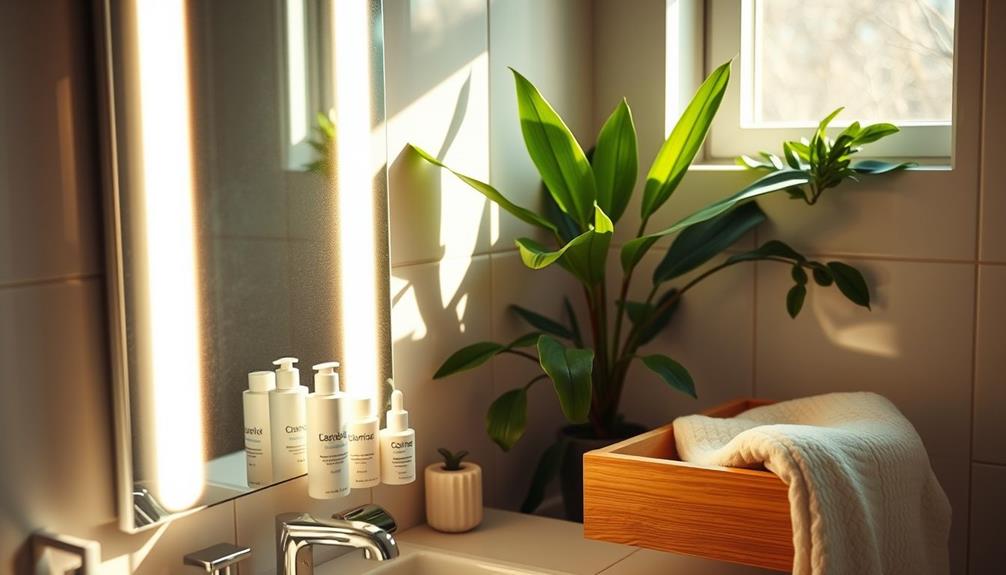
For ideal results with glycolic acid, apply it in the evening to minimize sun sensitivity and enhance your skin's overnight renewal process. Start with a low concentration of 5-10% and gradually increase usage to avoid irritation. After applying glycolic acid, always follow up with a hydrating moisturizer to support your skin barrier and prevent dryness, especially if you're using higher concentrations.
Consistent sun protection is essential. Use a broad-spectrum sunscreen with at least SPF 30 during the day to shield your newly exfoliated skin from UV damage and prevent hyperpigmentation. You can also maximize results by combining glycolic acid with other active ingredients like retinol or niacinamide on alternating nights. This approach targets multiple skin concerns while minimizing irritation.
Here's a quick reference table for your routine:
| Step | Recommendation |
|---|---|
| Application Time | Evening |
| Starting Concentration | 5-10% |
| Daily SPF | At least SPF 30 |
Following these tips will help you achieve smoother, brighter skin while keeping your skin barrier healthy and resilient. Remember, consistency is key!
Conclusion
Incorporating glycolic acid into your skincare routine is like adding a secret ingredient to your favorite recipe—it can transform your complexion from dull to dazzling!
With its ability to exfoliate and brighten, you're well on your way to achieving that smooth, radiant glow you've always wanted.
Just remember to start slow, listen to your skin, and soon you'll be basking in the confidence that comes from a luminous, rejuvenated look.
Your skin deserves this little magic!





